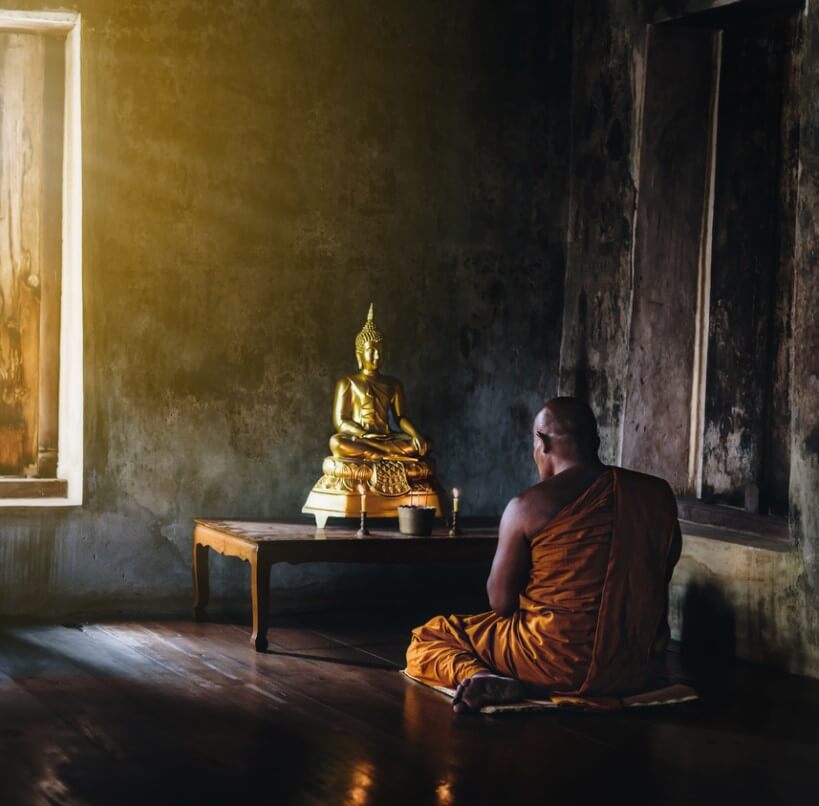Vipassana: how to practice this Buddhist meditation?
Written by: Loris Vitry (holistic coach)
Validated by: Cathy Maillot (Osteopath)
Caution: If you have any medical questions or concerns, please speak to your doctor. Even if the articles on this site are based on scientific studies, they do not replace professional medical advice, diagnosis or treatment.

In the seventies, a famous teacher named Satya Narayan Goenka initiated a yoga technique.
This is the Vipassana meditation.
This technique aims to discover the inner world and to focus exclusively on the present moment in order to purify the mind.
In this article, you will understand all about this technique and how to practice it.
Vipassana meditation: what is it?
In Pali, an ancient Indo-European language, the term Vipassana literally means “to see things for real”.
This technique is based on attention.
According to Buddha, attention is a kind of filter that serves to select exclusively what is beneficial to the person.
Therefore, this technique requires that the individual focus his attention on his five senses: (sight, hearing, taste, smell and touch) and on his thought.
In this way, he will be able to focus only on the present moment while remaining in reality.
This meditation technique therefore allows you to discover reality in its entirety.
The goal of Vipassana is to purify the mind, to eliminate tension and also to substitute positive thoughts for negative thoughts.
Therefore, Vipassana is a technique for conditioning the mind.
This technique is intended for all people with the requisite mental and physical resources and who are willing to follow the teacher’s instructions.
What are the benefits of Vipassana meditation?
Almost all meditation techniques have the same benefits.
However, studies performed have identified specific benefits of Vipassana meditation.
In this context, the benefits are quite significant.
- A reduction in addictive behavior: a study has shown that this technique caused a reduction in the consumption of certain substances such as alcohol, cocaine and marijuana in those tested.
- An increase in the feeling of well-being: this form of meditation gives a feeling of well-being characterized by a very positive mood and a decrease in pessimism.
- The reduction of anxiety, stress and the appearance of certain symptoms of depression: indeed, meditation has considerable effects on stress and anxiety.
- Improved concentration: When you focus your attention on your thoughts and feelings, you promote an increased attention span.
- Relief of tension headaches: a study carried out on 10 individuals was used to realize the beneficial effects of Vipassana meditation on tension headaches. skin conductance.This therefore served to reduce the intensity, frequency and duration of the headaches.
How to practice Vipassana meditation?
Ten days will be needed for a Vipasssana session.
During this period, participants cut off all contact with the outside world.
Indeed, they will not have the right to read, write, let alone perform an activity not included in the instructions.
Likewise, they must respect a moral code obliging them to remain celibate, to stop all drug use, but also not to kill, steal or lie, for the duration of the Vipassana session.
In addition, they can only take two meals a day and these meals should not contain meat.
During the first nine days of the session, participants can only communicate with the teacher when they wish to request information.
They are forbidden to talk to each other.
During the first three days and half of the fourth day, participants focus on breathing techniques to calm themselves down and have more concentration.
The next day, they focus on physical and mental sensations without resorting to their emotions.
As the session progresses, they develop their ability to observe their thoughts as well as get rid of their cravings and fears.
During the first few moments of the session, it is difficult to follow instructions and sit idly by.
However, over time, you gradually get used to it and the mind calms down.
At the end of the retreat, participants will be able to continue the practice of Vipassana meditation by repeating the same exercises without being assisted.
The different techniques of Vipassana meditation
Vipassana meditation can be practiced in several ways.
Observation of abdominal techniques
This exercise is done in a seated position with your back and head in front while being careful to stay upright.
It is an exercise that involves focusing on your breathing and observing the different stages of movement of our abdomen: when it rises and when it lowers.
We do not make this observation on the physical abdomen, but on the air which conditions its movement.
Observation of ideas, thoughts and thoughts
When an idea or an intention arises in the brain of the individual, this one must set up a kind of “mental note”.
For example, if the individual makes the decision to do something, he must mentally write down “decision”.
The goal is to become aware of his thoughts as well as his intentions up to the moment without other data obstructing his thinking.
The drowsiness observation
While practicing Vipassana meditation, it is normal for the individual to feel the urge to sleep.
When this sleepiness arises, the individual must be aware of this drowsiness, identify it and accept it.
When he does, he can transform this drowsiness into a meditation.
It has been understood that meditation is very useful in being able to improve one’s attention and increase the ability to control thoughts.
In this context, as explained above, several exercises can be performed to achieve a proven result.
This meditation technique, however, requires patience before you feel the first effects.
Indeed, at first the urge to give up may overwhelm you, but over the days, the results will come little by little.
Finally, this technique should enable you to be able to feel compassion for others.
Indeed, whether it is a relative, a stranger or even someone who has wronged you in the past, you must be able to let go of all self-control and feel only compassion.
Continue reading:
Animal totem and shamanism: how do you know which one is yours?

